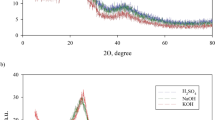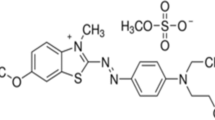Abstract
A novel biomass-based and low cost magnetic activated carbon (MAC) was synthesized from a peanut shell via a simple one-step method using hydrochloric acid pickling water as an activating agent. The effectiveness of MAC in the removal of methylene blue has been investigated extensively. The morphology and surface chemistry of the obtained MAC were characterized by Fourier transform infrared, X-ray diffraction spectra, scanning electron microscopy and Brunauer–Emmett–Teller surface area. A batch adsorption study was performed at varying pH levels, dye concentrations, temperatures, and adsorbent doses. In order to examine the adsorption kinetic and the mechanism of adsorption, pseudo-first-order, pseudo-second-order and intra-particle diffusion models were fitted. It was found that the equilibrium data were best represented by the Langmuir isotherm, with the maximum monolayer adsorption capacity of 201.61 mg/g at 298 K. The adsorption kinetic followed a pseudo-second-order equation. Thermodynamic study showed that the adsorption was a spontaneous and endothermic process.












Similar content being viewed by others
References
B. Royer, N.F. Cardoso, E.C. Lima, J.C.P. Vaghetti, R.C. Veses, Applications of Brazalin pine-fruit shell in natural and carbonized forms as adsorbents to removal of methylene blue from aqueous solutions: kinetics and equilibrium study. J. Hazard. Mater. 164, 1213–1222 (2009)
T.E. Rufford, D. Hulicova-Jurcakova, K. Khosla, Z. Zhu, G.Q. Lu, Microstructure and electrochemical double-layer capacitance of carbon electrodes prepared by zinc chloride activation of sugar cane bagasse. J. Power Sources 195, 912–918 (2010)
F.F. Avealr, M.L. Bianchi, M. Goncalves, E.G. de Mota, The use of piassava fibers (Attalea funifever) in the preparation of activated carbon. Bioresour. Technol. 101, 4639–4645 (2010)
M.S. Balathanigaimani, S. Wag-Guen, M.J. Lee, C.H. Kim, J.W. Lee, H. Moon, Highly porous electrodes from novel corn grains-based activated carbons for electrical double layer capacitors. Electrochem. Commun. 10, 868–871 (2008)
I.A.W. Tan, A.L. Ahmad, B.H. Hameed, Adsorption of basic dye using activated carbon prepared from oil palm shell: batch and fixed bed studies. Desalination 225, 13–28 (2008)
R. Malarvizhi, Y.S. Ho, The influence of pH and the structure of the dye molecules on adsorption isotherms modeling using activate carbon. Desalination 264, 97–101 (2010)
K.T. Samar, J.A. Muthanna, Adsorption of methylene blue onto biomass-based activated carbon by FeCl3 activation: Equilibrium, kinetics, and thermodynamic studies. J. Anal. Appl. Pyrol. 97, 116–122 (2012)
T.E. Rufford, D. Hulicova-Jurcakova, Z. Zhu, G.Q. Lu, A comparative study of chemical treatment by FeCl3, MgCl2, and ZnCl2 on microstructure, surface chemistry, and double-layer capacitance of carbons from waste biomass. J. Mater. Res. 25, 1451–1459 (2010)
J. Hristov, L. Fachikov, An overview of separation by magnetically stabilized beds: state-of-the-art and potential applications. China Particuology 5, 11–18 (2007)
H.Y. Zhu, R. Jiang, L. Xiao, G.M. Zeng, Preparation, characterization, adsorption kinetics and thermodynamics of novel magnetic chitosan enwrapping nanosized γ-Fe2O3 and multi-walled carbon nanotubes with enhanced adsorption properties for methyl orange. Bioresour. Technol. 101, 5063–5069 (2010)
I.A.W. Tan, B.H. Hameed, A.L. Ahmad, Equilibrium and kinetic studies on basic dye adsorption by oil palm fibre activated carbon. Chem. Eng. J. 127, 111–119 (2007)
J.J. Ma, L.Ch.. Zhou, W.F. Dan, H. Zhang, Y.M. Shao, C. Bao, L.G. Jing, Novel magnetic porous carbon spheres derived from chelating resin as a heterogeneous Fenton catalyst for the removal of methylene blue from aqueous solution. J. Colloid Interface Sci. 446, 298–306 (2015)
Sh.L. Zhang, L.H. Tao, M. Jiang, G.J. Gou, Z.W. Zhou, Single-step synthesis of magnetic activated carbon from peanut shell. Mater. Lett. 157, 281–284 (2015)
A. Devi, A. Singhal, R. Gupta, P. Panzade, A study on treatment methods of spent pickling liquor generated by pickling process of steel. Clean. Techn. Environ. Policy 16, 1515–1527 (2014)
L.C.A. Oliveiraa, E. Pereiraa, I.R. Guimaraesa, A. Vallone, M. Pereirac, J.P. Mesquitac, K. Sapag, Preparation of activated carbons from coffee husks utilizing FeCl3 and ZnCl2 as activating agents. J. Hazard. Mater. 165, 87–94 (2009)
S. Franger, P. Berthet, O. Dragos, R. Baddour-Hadjean, P. Bonville, J. Berthon, Large influence of the synthesis conditions on the physio-chemical properties of naostructured Fe3O4. J. Nanopart. Res. 9, 389–402 (2006)
L.C. Oliveira, R.V. Rios, J.D. Fabris, V. Garg, K. Sapag, R.M. Lago, Activated carbon/iron oxide magnetic composites for the adsorption of contaminants in water. Carbon 40, 2177–2183 (2002)
L.C.A. Oliveira, J.D. Fabris, W.N. Mussel et al., The effect of Mn substitution on the catalytic properties of ferrites. Stud. Surf. Sci. Catal. 130, 2165–2168 (2000)
E.N.E. Qada, S.J. Allen, G.M. Walker, Adsorption of methylene blue onto activated carbon produced from steam activated bituminous coal: a study of equilibrium adsorption isotherm. Chem. Eng. J. 124, 103–110 (2006)
B.H. Hameed, A.A. Ahmad, Batch adsorption of methylene blue from aqueous solution by garlic peel, an agricultural waste biomass. J. Hazard. Mater. 164, 870–875 (2009)
W.Ch.. Hsin, Adsorption of reactive dye onto carbon nanotubes: equilibrium, kinetics and thermodynamics. J. Hazard. Mater. 144, 93–100 (2007)
P.K. Malik, Use of activated carbons prepared from sawdust and rice-husk for adsorption of acid dyes: a case study of Acid Yellow 36. Dyes Pigments, 56, 239–249 (2003)
T.W. Weber, R.K. Chakkravorti, Pore and solid diffusion models for fixed bed adsorbers. AIChE J. 20, 228–238 (1974)
S. Arivoli, M. Hema, M. Karuppaiah, S. Saravanan, Adsorption of chromium ion by acid activated low cost carbon-kinetic, mechanistic, thermodynamic and equilibrium studies. J. Chem. 5, 820–831 (2008)
K. Fytianos, E. Voudrias, E. Kokkalis, Sorption-desorption behavior of 2,4-dichlorophenol by marine sediments. Chemosphere 40, 3–6 (2000)
L. Ch Zhou, J.J. Ma, H. Zhang, Y.M. Shao, Y.F. Li, Fabrication of magnetic carbon composites from peanut shells and its application as a heterogeneous Fenton catalyst in removal of methylene blue. Appl. Surf. Sci. 324, 490–498 (2015)
K.R. Hall, L.C. Eagleton, A. Acrivos, T. Vermeulen, Pore- and solid-diffusion kinetics in fixed-bed adsorption under constant-pattern conditions. Ind. Eng. Chem. Fundam. 5, 212–223 (1966)
Acknowledgements
The work was supported by the Shandong Natural Science Foundation of China (ZR2014BL014), a Project of Shandong Province Higher Educational Science and Technology Program (J14LC54), a Project of Binzhou City science and technology development project (2014ZC0212) and Binzhou University (201610449035 and BZXYHZ20161010) research Funds.
Author information
Authors and Affiliations
Corresponding author
Rights and permissions
About this article
Cite this article
Wang, F. A novel magnetic activated carbon produced via hydrochloric acid pickling water activation for methylene blue removal. J Porous Mater 25, 611–619 (2018). https://doi.org/10.1007/s10934-017-0474-2
Published:
Issue Date:
DOI: https://doi.org/10.1007/s10934-017-0474-2




